SuDS can be implemented on any development site. Certain site conditions may require adjustments to the design or type of components used, but even the most challenging sites must integrate SuDS in some form. Development proposals will be regarded favourably for maximising benefits and including multi-use features, not just focusing on water quantity.
Affordability
The costs of installing and maintaining SuDS are generally lower than conventional piped and tanked drainage. Where SuDS are integrated into the design at an early stage, they become part of the above-ground landscaping and building design, and there is less need for expensive hard-engineered solutions, such as over-sized pipes and underground storage.
Full lifetime costs should be considered. SuDS generally have low maintenance costs over their lifetime, with surface features like swales able to be maintained within landscape maintenance contracts. However, the costs of replacing/refurbishing permeable paving can be high.
The multiple benefits of SuDS should not be underestimated when assessing costs and benefits (CIRIA SuDS Manual Chapter 35). They can make SuDS schemes attractive to other organisations, who may be able to offer partnership funding opportunities and engage local communities.
SuDS design considerations:
- Consider SuDS design at an early stage and consult with all stakeholders to identify potential funding opportunities.
- Consider natural flow paths, low points and drainage catchments in locating SuDS components. This will optimise land take and reduce the need for deep excavation.
- Prioritise source control and surface systems to avoid hard-engineered and deep excavated solutions.
- Choose low maintenance designs, which can be maintained under standard landscaping contracts.
- Deal with waste on-site.
 Wetland SuDS feature
Wetland SuDS featureSafety
SuDS in Somerset must be safe for residents and operators (Somerset Local Standard L16). Designers have responsibilities under the Construction (Design and Maintenance) Regulations 2015 (CDM) to eliminate, reduce or control foreseeable risks during construction, maintenance and use of a structure.
As SuDS are no more hazardous than natural waterbodies, health and safety concerns are not accepted as a reason for excluding them in development. Potential health and safety risks can be overcome through good SuDS design (see CIRIA SuDS Manual Part D and Chapter 36). The risks should be balanced against the benefits for health and well-being. Where health and safety is raised as a concern, public perception of risk can often be addressed through community.
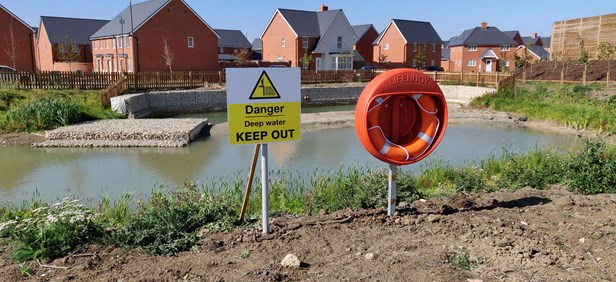 Health and safety signage at detention basin
Health and safety signage at detention basin
Maintenance
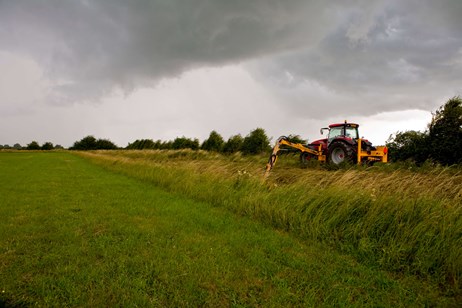 Maintenance of a watercourse
Maintenance of a watercourseSuDS are no more difficult to maintain than traditional piped drainage systems. In fact, above-ground SuDS features allow blockages or structure failures to be identified and managed more easily than below-ground drainage systems.
Maintenance for vegetated SuDS, such as swales and basins, can be incorporated with general landscaping maintenance tasks for a site, including mowing and removing weeds.
Difficulty or cost of maintenance will not be accepted as a reason to exclude SuDS within a development site. In Somerset SuDS must be designed to be passively or easily maintained (Somerset Local Design Standard L17). More information on maintenance can be found here.
The CIRIA SuDS Manual provides a generic list of maintenance tasks for each type of SuDS feature. These should be reviewed and tailored to the conditions of an individual development site, within a Maintenance and Operation Plan. Further details on planning for maintenance can be found here.
Small sites
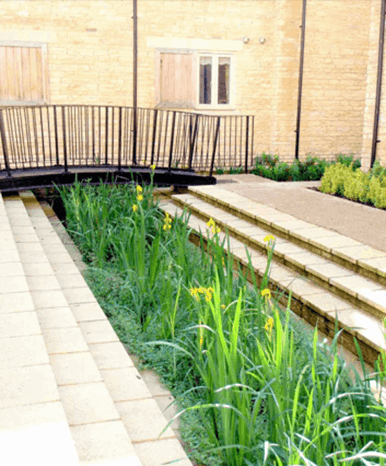 Planted rill in a new development
Planted rill in a new development
Brownfield developments may be small in space or restricted by existing infrastructure. It may be perceived that site profitability will be reduced by the land-take associated with larger surface SuDS such as swales and ponds/wetlands.
There are a range of space-efficient SuDS techniques. Source control is a key concept, and opportunities can be maximised where strategic SuDS design is considered at an early stage. All available public and private space can be utilised (e.g. verges, small pockets of grass or paving). Incorporating SuDS into landscaping can significantly improve the amenity value of brownfield sites for residents. High density housing will not be accepted as a reason to exclude SuDS in Somerset.
Design tips for small or brownfield sites:
- Green roofs, rainwater capture and reuse, infiltration systems, permeable paving, bioretention areas, tree pits and micro-wetlands are all possible on space-restricted sites.
- Non-trafficked paved areas can be made permeable (pavements/footpaths, parking).
- Rills, channels and depressions can be built into the hardscape and planted to provide attractive water features.
- Swales, filter strips, ponds and large wetlands are less suitable.
- Access to existing underground infrastructure, such as utilities, will need to be considered in the design.
- Concentrated infiltration components such as soakaways must be 5m from a building, however this does not apply to permeable paving with infiltration.
Photo credit: Cambridge City Council
Sites with poor permeability
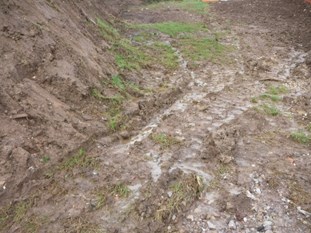 Poor permeability on a construction site
Poor permeability on a construction siteSoils/geology with low permeability are often given as a reason not to include SuDS on a site. Lower permeability is seen in the southern and eastern areas of Somerset, as well as along the coastline, where there is coverage of Lias Mudstone. This includes Yeovil, Ilminster, Glastonbury and Highbridge. However, almost all SuDS components can still be used in areas of low permeability, with some modifications.
Design tips for low permeability sites:
- All SuDS except infiltration systems can be used on low permeability sites. Above ground storage components should be used to provide the required attenuation and treatment.
- Greenfield runoff rates tend to be high on low permeability geologies, so attenuation requirements should be more manageable.
- Permeable paving can still be used for storage, although it may require an underdrain.
Sites at flood risk
Flood risks can come from various sources: coastal, fluvial (river), pluvial (surface water), sewer systems, reservoirs and high groundwater levels. Areas of Somerset such as the Moors and Levels, Yeovil and Bridgwater, are at high risk of flooding from several sources.
A Flood Risk Assessment is required for any site that is at flood risk from any source, or that is over 1ha in size. Check if your site is at flood risk here.
Despite the challenges which flooding can cause for development, it can also provide opportunities. Understanding the causes and impacts of flooding on a site can allow natural flow paths and flood extents to be harnessed and incorporated into the SuDS design.
Fluvial flood risk
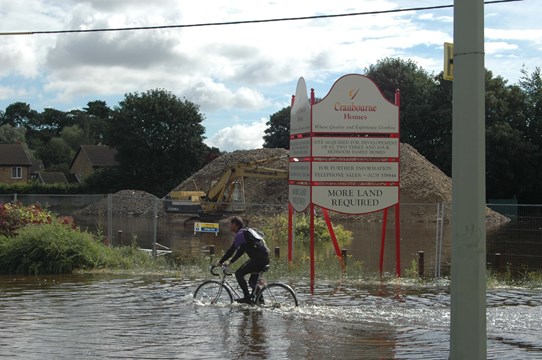 Flooded road outside proposed development site
Flooded road outside proposed development siteDesign tips for sites at fluvial flood risk (within Flood Zone 2 and 3):
- Storage for runoff from the development in extreme events should be located out of the floodplain in Flood Zone 1.
- Floodplain areas can provide treatment for more frequent events, if floodplain capacity is not reduced. The effects of modelled fluvial water levels, frequency, duration and velocities on performance of SuDS components, and the risk of damage by erosion should be considered.
- Consider the maintenance implications of silt deposition from a flood event.
- Design attenuation SuDS with a sufficient drain-down time (to half-empty within 24 hours) following a storm event to allow for it to receive runoff from subsequent events (see Somerset Local Design Standard L4).
Surface water
Well-designed SuDS can improve surface water flood risk both on and off the site. Design tips for sites at surface water flood risk:
- Assess and design for additional surface water flows entering the site.
- Design for natural drainage pathways - existing surface water flow routes should be identified and integrated into the exceedance design for the site.
Groundwater flood risk and high groundwater levels
 High groundwater in detention basin
High groundwater in detention basinSite investigations, informed by local flooding incidents, should be undertaken to identify if the site is prone to high groundwater levels. Infiltration testing and groundwater monitoring should be undertaken in accordance with Somerset Local Standard L9.
High groundwater levels during extreme wet periods may render infiltration SuDS ineffective and pose a direct pollution risk to groundwater. If levels are very high, groundwater may enter the SuDS feature and reduce the storage capacity and structural integrity of the design. Design tips for sites at groundwater flood risk:
- The base of an infiltration system should be located at least 1m above the likely maximum water table in accordance with Somerset Local Standard L9. Groundwater quality protection must be considered for infiltration SuDS where the seasonal water table is high.
- Avoid locating below-ground features such as tanks below the maximum groundwater level, as pressure loads are likely to be high.
- Shallow surface features such as swales, ponds and permeable pavements can be lined with an impermeable layer to isolate SuDS from groundwater.
- On-site ground investigations are required prior to the design and construction of infiltration SuDS or deep storage features.
Photo credit: The UK Groundwater Forum
Contaminated sites
Water infiltrating through affected soils can mobilise contaminants and pose a pollution risk to groundwater. In Somerset, many contaminated land sites relate to historic industries, including:
 Oil pollution in a SuDS pond
Oil pollution in a SuDS pond- cloth production – e.g. Wellington
- tanning and leather works - e.g. Glastonbury
- gas works in major towns - e.g. Taunton
- metal-working – e.g. Frome
- mineral and aggregate mining - e.g. the Exmoor and Brendon Hills
- railway and port infrastructure - e.g. around Minehead.
Excavation and disposal of contaminated soils is expensive, and SuDS may compromise remediation measures in place to protect residents from contamination. However contaminated land will not be accepted as a reason to exclude SuDS.
Tips for designing SuDS on contaminated land:
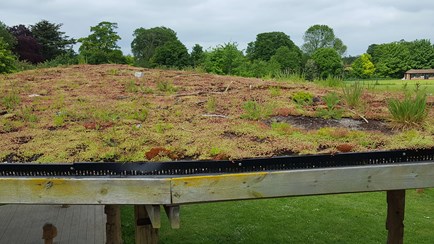 Green roof installed in play area
Green roof installed in play area- Green roofs and rainwater capture and reuse can be used as normal on contaminated sites
- Use of shallow surface features can reduce the need to excavate contaminated ground.
- Seek early advice from a geo-environmental professional so that drainage design and remediation strategies for contamination can be integrated (e.g. capping layer can be extended beneath SuDS).
- Suitability of infiltration systems will depend on testing the leaching potential of contaminants. Infiltration may be possible at greater depth, below the contaminated layer. Alternatively, contaminated soil around soakaways can be removed and replaced.
- If infiltration is not possible, shallow surface features such as basins, swales, ponds and permeable pavements can be lined with an impermeable layer to prevent infiltration.
- Materials should be assessed for durability when exposed to contaminants (as for any other construction material in this situation).
Flat or steep sites
 Swale intercepting road runoff
Swale intercepting road runoff
Managing surface water on the surface tends to provide the best solution for flat sites. All runoff should be managed as close to the source as possible. Flat, low-lying sites are likely to be found on the Somerset coastline and within the Somerset Levels.
Tips for designing SuDS on flat sites:
- Green roofs, rainwater capture and reuse and permeable paving can be used as normal on flat sites
- Keep water on the surface and use conveyance methods of kerbs, shallow rills and swales.
- Design should be based on small sub-catchments with storage and conveyance managed close to source. Hydraulic head will build up locally and push water out of the system.
- Pumped systems are not acceptable by the Lead Local Flood Authority or the Somerset Drainage Board Consortium under Somerset's Local Standards.
Steep slopes (>5%) can generate high flow velocities of runoff, but these can be managed with good design. Steep sites are likely in the Mendip Hills, Quantock Hills, Brendon Hills, Blackdown Hills and within Exmoor National Park.
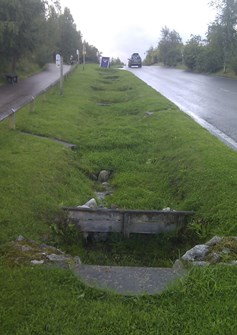 Roadside swale with check dams on steep slope
Roadside swale with check dams on steep slope
Tips for designing SuDS on steep sites:
- Green roofs, rainwater capture and reuse can be used as normal on steep sites.
- The system design should be based on small sub-catchments with storage and conveyance managed close to source.
- Features such as permeable paving, bioretention areas, swales and wetland can be terraced or designed to follow contours.
- Erosion protection can be provided for steep conveyance features such as waterfalls, stones set into the bed of channels etc.
- Check dams can be placed in swales to slow runoff velocities. These should be installed as early as possible in the construction process, to prevent erosion.
- Check dams can be used to manage storage within permeable paving on a slope. However, very steep slopes may increase runoff from permeable pavements, making them less effective.
Industrial sites
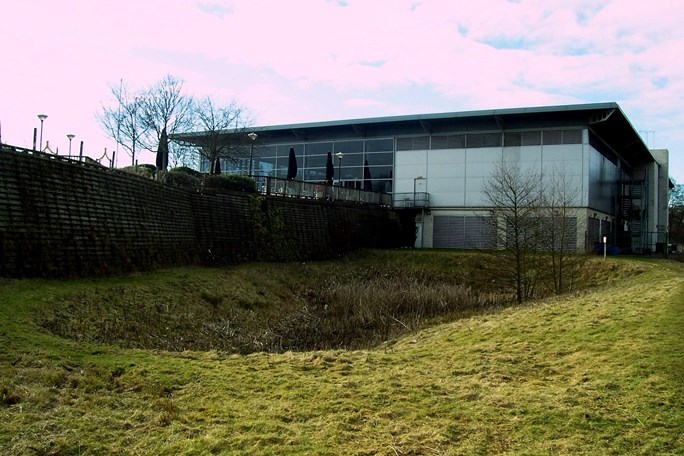 Detention basin on industrial site
Detention basin on industrial siteCare must be taken when designing SuDS for some commercial and industrial sites, particularly where storage, handling or use of hazardous substances occurs (such as for example, garage forecourts, coach and lorry parks/turning areas and metal recycling/vehicle dismantling facilities).
Tips for designing SuDS on industrial sites:
- Runoff from ‘safe’ areas (e.g. roofs or car parks) should be separated and drained through SuDS.
- SuDS such as swales, permeable paving and bioretention areas can be lined if there is a risk of contamination.
- Runoff from areas with a high risk of contamination from hazardous substances should be separated, contained and dealt with as industrial waste.
- Discharges of surface water run-off to ground at pollutant storage sites are likely to require an environmental permit from the Environment Agency. The site will be subject to risk assessment and provision of acceptable effluent treatment.
Water quality assessment should be carried out to the appropriate level, as set out in Somerset Design Standard L11.

